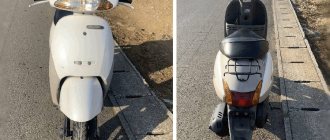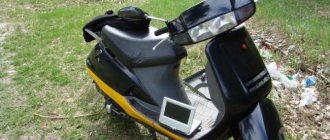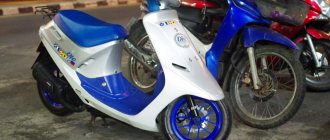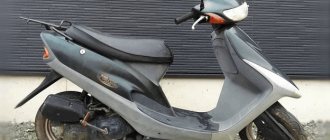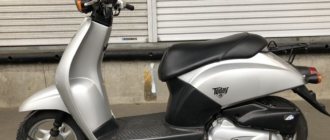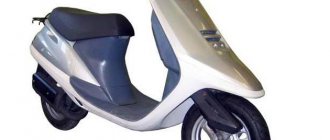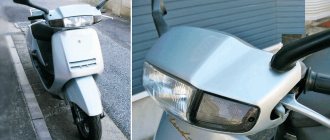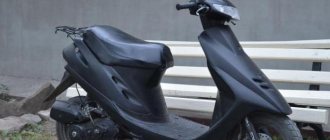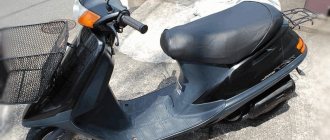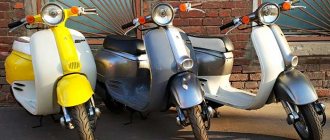The scooter was developed by the Japanese company Honda. Produced in Thailand from 2009 to the present. Since 2012, it has been produced in 2 versions: with a 125 cc engine. and 150 cc.
Modern style, reliable and maneuverable chassis, economical injection engine, and thoughtful ergonomics have made the Honda PCX a global bestseller. This model is sold successfully not only in Asia and Europe, but is also supplied to the USA. It is not in great demand on the Russian market due to its high cost.
Specifications Honda PCX
- type - small-capacity scooter, maxi-scooter.
- Country of origin: Thailand (Thai Honda Manufacturing).
- model name - Honda PCX 125/150, Honda PCX.
- years of production - from 2009 to the present. In 2012, a version with a 150 cc engine appeared.
Engine:
- working volume - 125 cubic meters. cm (124.9 cm3), model PCX 150 - 150 cc. cm (152.9 cm3)
- 1-cylinder, 4-stroke.
- maximum power - 11.7 hp. (8.6 kW), PCX 150 model - 13.5 hp. (10 kW) at 8500 rpm.
- cylinder diameter/piston stroke - 52.4/57.9 mm, PCX 150 model - 58.0/57.9 mm.
- compression ratio - 11.0:1.
- cooling system – liquid.
- fuel supply system – injector, electronic fuel injection PGM-FI.
- ignition system - electronically controlled, transistor.
- starting system - electric starter.
Transmission, chassis, brake system:
- the base is a spinal frame made of steel pipes.
- type - V-Matic V-belt variator.
- drive - belt.
- front suspension - 31 mm telescopic fork. Working stroke - 100 mm.
- rear suspension - pendulum type with two shock absorbers. Stroke - 75 mm.
- braking system - combined (CBS).
- front brakes - disc, 1 disc, diameter - 220 mm, 3-piston caliper.
- rear brakes - drum, drum diameter - 130 mm.
Dimensions:
- length - 1915 mm.
- width - 740 mm.
- height - 1090 mm.
- seat height – 760 mm.
- wheelbase - 1305 mm, model PCX 150 - 1315 mm.
- ground clearance (ground clearance) - 130 mm.
- weight – 126 kg.
- maximum load - 180 kg.
Wheels:
- wheels - 5-spoke cast aluminum alloy wheels, road tires.
- Front tire size: 90/90 R14 M/C.
- rear tire size - 100/90 R14 M/C.
Other information:
- Fuel tank volume – 6.1 l.
- the volume of oil to be filled is 0.8 l.
- Recommended fuel is gasoline with an octane rating of at least AI-92.
- fuel consumption - 2.5 l. 100 km (with Idling Stop system).
- maximum speed - 100 km/h. (150 cc version - 120 km/h).
- Color options: white, red, black, gray, brown.
- price - 200,000 rub.
Preface: I wanted to write this review back in '12. I've ridden the PCX a few times, but the most I've ridden this scooter was in Thailand in August 2012. Our acquaintance was memorable, and then I found out that the Honda PCX 150 recently began to be sold in Russia. This reminded me of wanting to write this article. Better late than never. Well, a good test must be aged, just like good alcohol.
Anyone who has been to Thailand could not help but pay attention to these cute bikes. They are literally everywhere there. This is not surprising: the scooter is manufactured at Thai Honda Manufacturing, Honda's plant in Thailand. Both locals and tourists love them, and the latter so much that the nickname “Farang-bike” (Farang - foreigner (Thai)) even stuck to it in Thailand...
Production of the Honda PCX 125 began in 2009. In 2012, a version with a 150 cc engine appeared, which is produced in parallel with the 125 cc version. The Honda PCX scooter is a global bestseller. It sells well in both Asia and Europe. The model is even supplied to the USA. Why, the whole snickering world, as mentioned above, this is one of the few scooters of the “big Japanese four” that can be bought from us new, under warranty and absolutely officially.
August in Thailand is the rainy season. That year in 2012, according to locals, the country was hit by a particularly bad monsoon, so the conditions for getting to know the scooter were quite extreme - it rained non-stop most days of the test. But this did not stop your humble servant from trying to figure out what is the secret of the popularity of the Honda PCX? Getting wet, freezing, sliding on wet roads, and then damaging his own liver while warming up in Thai bars, brave Sanchez and his faithful and even braver half Pachulya tested the Honda PCX 125 in tail and mane.
So:
First of all, the scooter attracts with its design and non-standard layout. The massive and “evil” headlight in the style of the fresh Honda VFR creates the appearance of a much larger and more serious device than it actually is.
A shortened tinted windshield, a dynamic silhouette in high-tech style, an open chrome steering wheel, narrow mirrors, a liquid crystal dashboard...
And there are also a great variety of options for painting the body panels of the scooter and its seat. All this enhances the impression of a serious modern maxi-scooter.
However, PCX is not. It is larger than most 100-150 cc models, but at the same time much smaller than real maxi scooters, in the modern sense.
For comparison, the dimensions of the Honda PCX are 1915 x 740 x 1090. At the same time, the well-known SYM Joyride 200 has dimensions: 2010x760x1155. But the Joy is a very small scooter; next to the same GTS 250 it seems like an overgrown half-length. Therefore, it is not surprising that after the pictures on the Internet, I was surprised by the actual very small size of the scooter. This is not to say that it is small, but calling it a maxi-scooter is completely wrong.
However, the car is a full two-seater. The seat is large and divided into two parts by a small backrest for the pilot. Your +1ka can quite comfortably endure long trips with you without much inconvenience.
It offers comfortable folding motorcycle-type footrests and handles on the tail of the bike.
However, the correct +1ki is to hold on to the pilot’s waist, as is known, so we didn’t really use this option. But lifting the scooter onto the center stand, holding on to these handles, is very convenient. By the way, in addition to the central one, there is also a side step. It's women-friendly, and the PCX is harder to pull onto the center stand than most of its similarly sized siblings.
The pilot is also comfortable and spacious. There was enough legroom for me (180cm tall). The front shield is of a complex shape for the sake of design and technical solutions; its protection against dirt and wind, in my opinion, is worse than standard scooter solutions, but overall everything is very good. The volume of the seat space is 25 liters. Same as SYM JoyRide 200i. But for a maxi-scooter this is not enough (for comparison, the SYM GTS250 is 45 liters). But we have already decided, the PCX is not a maxi-scooter.
The trunk profile is long and not deep, two open helmets will not fit, but if you pile on a bunch of flexible things, such as a motorcycle jacket or bags of groceries, quite a lot will fit. On the left under the steering wheel there is an additional one and a half liter glove compartment for small items.
There is a high tunnel between the legs, enhancing the effect of the super-mega-sportiness and modernity of the bike. Well, you can also wrap your legs around it more tightly while taxiing, this will especially appeal to “clean” motorcyclists - they are always bothered by the lack of close contact with the car on a scooter.
The scooter handles very well and predictably for its class, and with a passenger too. Thanks also to the large 14-inch wheels. Once we got lost in Patong and turned onto a street completely flooded with water. Damn monsoons!
Water periodically washed over the floor, and steam hissed from the hot muffler. A huge fuel tanker was barely dragging ahead of us, and oncoming cars were walking in the adjacent lane. All this created rather large waves, which in every possible way knocked the scooter off course. I absolutely didn’t want to put my feet into the muddy brown slurry seething under the wheels, so raising my feet higher above the water, we drove without stopping at a steady, slow throttle. The scooter was taken out! It didn’t stall (despite the fact that the air filter was periodically flooded), it wasn’t hit by a wave, it simply drove through the water as if on dry land, drove onto the road straight out of the water, like some kind of amphibious infantry fighting vehicle, and calmly moved on.
In general, as far as reliability is concerned, the scooter did not give a single reason to reproach itself. It always started with half a turn, despite the monstrous humidity. At the same time, he often spent the night with us right in the open air, from which rain streams poured down (the point is not our sloppiness, but the lack of a canopy in the hotel parking lot). The fact is that the scooter is not only made in high-tech design. The technical content is also very modern. The scooter's engine is 4-stroke, injection, and has PGM-FI electronic fuel injection. All versions of PCX (except for the US version :)) have a switchable Idling Stop system in the base, which is controlled by a switch located on the steering wheel, on the right remote control.
When this system is activated, the engine automatically stops after 3 seconds of idling and restarts when the throttle is turned. Everything happens quite quickly and almost silently. This allows you to save fuel and reduce exhaust emissions into the atmosphere. In practice, although the engine does start quickly, this system really infuriated me and I turned it off. Still, during dynamic driving, a split-second delay is felt. Well, for me, far from modern technologies and new equipment, an engine that suddenly died down at a traffic light did not evoke a benevolent smile and pride in my concern for the environment, but panic and an attempt to urgently restart the “stalled” engine. In short, I tried it and turned it off.
PCX's consumption is quite small even without this function. I don’t remember the exact numbers, but I refueled with traditional Thai bottles (there are few gas stations in Thailand, but almost everywhere along the road you can buy a 0.7 liter glass bottle of gasoline) and did it infrequently and cheaply. The manufacturer claims 3.3 l/100 km in the combined cycle, which seems to be true. At the same time, the tank, the neck of which is located on the central tunnel, is quite large for such a flow rate - 6 liters.
The “technique on the verge of fantasy” does not end there. The scooter in the database is equipped with a beautiful and informative instrument panel with an LCD display, which displays a lot of useful information. The instruments are easy to read, even under the bright southern sun.
The trunk and gas tank lids are equipped with electric locks and open with a button. Which is really convenient. Everyone has faced the situation when they plopped down on the saddle, started the engine, and then remembered that they forgot something in the underseat glove compartment. I have to turn off the engine to remove the key and open the trunk. Here you don’t have to turn off anything, but simply press the button next to the ignition switch.
The base also has an alarm system with a motion-shock sensor. It turns on from the key fob, beeps very quietly and timidly and blinks the turn signals. It seems that the alarm does not scare away the attacker, but begs for mercy, trying to pity him. Enchantingly useless in this performance.
The alarm control panel is made with a separate key fob. At the end of the ignition key there is a hexagon that can be used to raise/lower the metal curtain that covers the keyhole of the ignition key itself. Also an anti-theft system.
The brakes are not so modern: the front is disc, but the rear is old-fashioned drum. However, even here the cunning Japanese could not do everything primitively and installed the combined braking system (CBS), already familiar to Honda scooters. When braking with one lever, the front and rear brakes are applied simultaneously.
As a result, the PCX brakes were always enough for me personally. Let me remind you that most of the time I drove on a wet road and with a passenger. The brakes are quite adequate for the dynamic performance of this scooter.
But the dynamic performance itself is probably the saddest thing about this scooter. They write on the Internet that the PCX 125 accelerates to 100 km/h, and the 150 cc version can reach up to 120 km/h. Personally, I was able to accelerate a Honda PCX 125 with a slender passenger to only 85 km/h on the speedometer. Then there was simply not enough straight road for me, it all happened so slowly and drearily. The dynamics of the scooter seemed very mediocre. More precisely, it’s not entirely true, the dynamics are not outstanding, but they correspond to the capabilities of a 125 cc 4-stroke water-cooled single-pot engine.
The trouble is that after such a stunning appearance and other bells and whistles, you subconsciously expect completely different dynamics from the PCX. A technically successful, but leisurely and utilitarian scooter has been dressed up in a stunningly sporty, aggressive body kit.
PCX unexpectedly evoked an association in me with the Apple iPhone. That one is also a beautiful, high-tech, interesting device with a bunch of different useful functions. But for all its undeniable advantages, it is the main, telephone component that is very weak. The reception is weak, the battery is voracious. It’s the same with the PCX - it’s generally awesome, if not for the dynamic performance. This is his personal fly in the ointment. Everything is subjective, but miracles don’t happen - no high-tech will add performance to a 125 cc runaway with a CVT.
That is, of course you can drive around Moscow, but... If you look at its price at Honda dealers in Russia and estimate possible alternatives within this budget, you won’t want to. Don't get me wrong - the PCX is a great scooter. Very beautiful, reliable and practical, with excellent handling and brakes (within its class), but I can’t imagine it in Moscow. He absorbed the beauty and leisurely nature of the carefree and cheerful inhabitants of the coastal southern villages, and here is not his habitat at all. He simply physically cannot adapt to the crazy rhythm of the roads of our evil metropolis... For Moscow, he needs an engine of 200 cubic meters - it would turn out to be an amazing device for our conditions. Reliable, modern, small and nimble in traffic jams, two-seater, practical and dynamic, beautiful ponto-launcher. But in its current form, buying it for driving in Moscow is contrary to common sense.
That being said, when I return to Southeast Asia again, I will be very happy to rent it on the first day. And I won’t even look at anything else. Your healthy and powerful T-max and SilverWing are as out of place there as PCX is here. To Caesar what is Caesar's, and to God what is God's...
